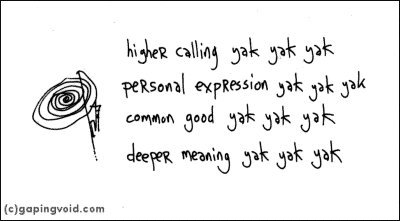VERY LONG BUT WORTH THE READ

I could not possibly say this better. Rock on Pink Air
A couple of weeks ago, I went to the Darwin exhibit at the Museum of Natural History in New York with my friend Ted. He pointed toward a small glass case and said, "This is my favorite part."
Inside the case was a small red notebook, flipped open to a page on which Darwin had written "I think" over what is likely the first depiction of an evolutionary tree.(1) When I realized what I was looking at, I had to manfully restrain a sudden impulse to weep. You may say I'm just a wuss, but you are (tragically though forgivably) blinded by the Fundamental Attribution Error. I blame it on the aura.
I came across the idea of aura when I was doing branding research for a museum. One of their main questions was about the role of museums in an age of ubiquitous digital reproductions. Walter Benjamin (the patron saint of interestingness) used the word aura to encompass what is stripped away when an object is mechanically reproduced. He noted that many "art" objects were originally produced as religious artifacts whose unique position in space and time was what gave them value. Without the uniqueness and authenticity of the original, copies have no religious value.
I think of aura as the fingerprint of interestingness. Objects with a historical, physical connection to what we find interesting(2), will induce the sensation of aura: religious, mesmerizing, a kind of "stepping into the light", a satisfying yet unsatisfiable, quasi-physical engagement with the mental stuff of interest.
The commercial nature of brands gives them a huge advantage over other sorts of ideas when it comes to aura generation. While a typical authentic artifact, like Darwin's notebook, must be unique to create an aura, a branded product can be (re)produced millions of times with no decline in aura per unit.(3) Because in many ways the product is the brand while a notebook, even from Darwin's own hand, is not the idea of evolution.
Also, you interact with a branded product in a much more intimate, personal way than you can with typical aurigenic artifacts, which are usually sealed up in glass boxes and not much good for wearing, playing or eating anyway. You have the equivalent of a speaking part in the brand play, and that's much more compelling than being one of the anonymous, weeping extras filing past in the museum.
(1) Please pardon the crappy cell phone photo. I was using the "crappy" filter on my cell phone.
(2) Does this make the objects themselves interesting? There's a conceptual tangle here.
(3) Isn't this something a cartoon villain would say?

0 Comments:
Post a Comment
<< Home